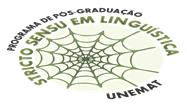Banca de QUALIFICAÇÃO: WELICA CRISTINA DUARTE DE OLIVEIRA
Uma banca de QUALIFICAÇÃO de DOUTORADO foi cadastrada pelo programa.DISCENTE : WELICA CRISTINA DUARTE DE OLIVEIRA
DATA : 11/07/2025
HORA: 13:30
LOCAL: https://meet.google.com/juy-oopd-oec
TÍTULO:
CLASSROOM BETWEEN ONLINE AND OFFLINE PRACTICES: PLACE, SPACE AND ENGLISH LANGUAGE TEACHING AFFORDANCES IN MATO GROSSO
PALAVRAS-CHAVES:
English language teaching, affordances, place, Place-based learning, technology integration.
PÁGINAS: 120
GRANDE ÁREA: Lingüística, Letras e Artes
ÁREA: Lingüística
SUBÁREA: Lingüística Aplicada
RESUMO:
In contexts where English is taught as a foreign language, especially in public schools, the construction of meaningful pedagogical practices represents a constant challenge. In the state of Mato Grosso, this reality is affected by a series of factors that hinder the full perception and use of affordances (Gibson, Van Lier, 2002; Aronin, 2004; Scarantino, 2003) that emerge in this process, such as student demotivation, structural and space/time limitations, challenges in accessing and critically using contextualized pedagogical materials, and the gap between the pedagogical, critical, and technological dimensions in teaching and teacher training. Although digital technologies and media offer multiple dynamic resources that favor the development of 21st century literacies, their meaningful integration remains limited. It is observed that the difficulty in connecting English teaching to students' experiences, combined with the lack of a situated approach, continues to be a frequent obstacle in public schools. In light of this, we propose the adoption of reflective and evaluative movements, capable of guiding a purposeful integration of technology in English teaching, contextualized, articulated with space (Lefebvre 1991; Soja 1989; 1996; Massey 2005) and with students' sense of place. From a rhizomatic perspective (Deleuze & Guattari, 1995; Latour, 2012) of educational networks, and based on contributions in the field of Place-based learning (Sobel, 2004; Gruenewald & Smith, 2008), critical applied linguistics (pennycook, 2010) and theoretical movements of space and language in posthumanism (Lenters & Mcdermott, 2019; Comber, 2016) this proposal aims to transform the English class experience into an opportunity that expands students' identity bonds and strengthens their agency in different fields of action, both online and in embodied experiences in their community.
MEMBROS DA BANCA:
Interno - 466.104.133-04 - ALEXANDRE MELO DE SOUSA - UFAC
Interna - 132146001 - BARBARA CRISTINA GALLARDO
Externa ao Programa - 82419001 - OLANDINA DELLA JUSTINA
Externa à Instituição - DENISE HIBARINO - UFPR
Externa à Instituição - SOUZANA MIZON - UNIFESP



